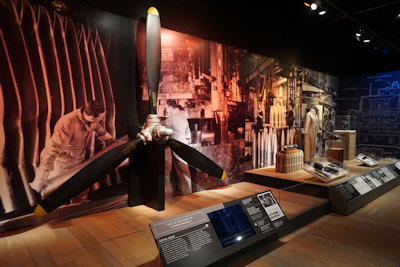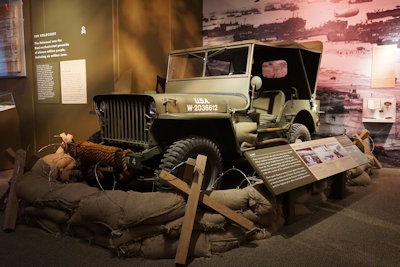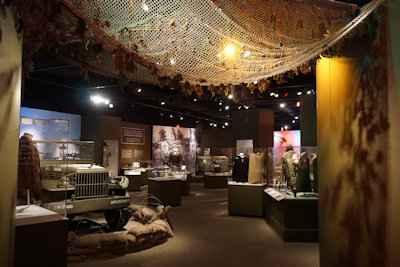
World War II was arguably the greatest tragedy in the history of the human race. From Europe to the Pacific Ocean, the planet was engulfed in a battle that raged for over half a decade, leaving millions of dead in its wake and destruction on a scale never before imagined. In 2015, the Senator John Heinz History Center in Pittsburgh paid tribute to the men and women who sacrificed their lives in that struggle – as well as the role the region played in the ultimate fight for freedom – with its We Can Do It! exhibit, which premiered in April and remained on display through the end of the year.
An estimated 1.25 million Pennsylvanians served in the armed forces during World War II, with 175,000 of that number coming from the Pittsburgh region. The Steel City did more than contribute to the millions of men and women who fought overseas, however, as its manufacturing might likewise played a key role in the outcome of the conflict.
“By the time Japan attacked Pearl Harbor, Pennsylvania industries had been making war materials for more than a year,” the Heinz History Center explained. “America’s entry into the war intensified that need. Pittsburgh led the way as Pennsylvania businesses turned to war production. Heinz built gliders. Westinghouse made torpedoes. Dravo engineered an assembly line for building ships. U.S. Steel smashed production records as the region’s mills poured 95 million tons of steel into the effort. By 1945, Pennsylvania produced as much steel as all the Axis powers combined.”
In addition to the city’s steel making capabilities, other area companies also played significant roles during World War II, and the We Can Do It! exhibit highlighted many of their achievements. Westinghouse Electric did more than build torpedoes, for instance, as helmet liners, bomb fusers, tank-gun stabilizers, and radar systems likewise rolled off their assembly lines. Pittsburgh Plate Glass, meanwhile, developed new plastic resins and fiberglass that were used as aircraft windshields, while other PPG technologies improved the durability and safety of battleships, trucks, and tanks.
Technological innovations like the automobile and airplane influenced the ways that wars were fought in the twentieth century, and the War Department needed a new light-weight motor vehicle as part of its efforts during World War II. The American Bantam Car Company in nearby Butler, Pennsylvania, was one of only three manufacturers in the country to deliver a working prototype within the timeframe dictated by U.S. Army.
Bantam was on the verge of bankruptcy when it invented the Jeep, and its uncertain financial footing and small manufacturing capabilities resulted Willys-Overland Motors and the Ford Motor Company taking over mass production of the vehicle. Despite their limitations, the American Bantam Car Company still manufactured 2,765 Jeeps during the early 1940s.
Butler was not the only nearby community to play an important role during World War II. British Prime Minister Winston Churchill once referred to George C. Marshall as the “true organizer of victory,” and the Army General was born and raised in Uniontown, Pennsylvania, located 46 miles southeast of Pittsburgh.
Marshall rose to Chief of Staff on September 1, 1939, the same day that Adolph Hitler invaded Poland. The U.S. Army only had 200,000 soldiers at the time, but under Marshall that number rose to 3 million by 1942 and 8 million in 1945 – the largest military expansion in the history of the United States.
It wasn’t just men who contributed to the war effort, but women as well. Recruits into the armed forces after the Japanese bombing of Pearl Harbor led to workforce reductions in the plants and steel mills of not only Pittsburgh but throughout the United States, and it was left to women to fill the production voids. The Heinz History Center estimated that more than 30,000 women were working at U.S. Steel by September 1943.
To both commemorate and inspire this new workforce, artist J. Howard Miller created a poster of a female Westinghouse Electric employee rolling up her sleeves under the caption “We Can Do It!” Miller was inspired by the photograph of a Michigan factory worker, and famed illustrator Norman Rockwell likewise crafted a cover for the Saturday Evening Post that featured a female worker taking a lunch break.
Rockwell’s painting was called “Rosie the Riveter” and the name was soon transferred to Miller’s poster as well, resulting in one of the most iconic images of not only World War II but the entire twentieth century.
Efforts on the home front were only one of the ways that Pittsburgh contributed to the war effort, and the We Can Do It! exhibit at the Heinz History Center likewise paid homage to the men and women who served in the armed forces. Many of those veterans, as well as their families, contributed artifacts from the war as part of the installation, and together they conveyed the story of World War II from the soldier’s perspective.
Although only a small handful of those narratives were contained at the Heinz History Center, they served as a microcosm for the experiences of all 175,000 men and women from the Pittsburgh region who were stationed in Europe and the Pacific nonetheless.
It required a massive effort to defeat Nazi Germany and Imperial Japan during World War II, and millions of lives from around the globe were lost during the conflict. Pittsburgh is a long way from the beaches of Normandy or the sands of Iwo Jima but the effects of the war were felt in Western Pennsylvania just the same.
The Steel City may not have been the solitary key to victory but it still played an important role, and the We Can Do It! exhibit at the Senator John Heinz History Center served as a tribute to not only those efforts but the thousands of men and women from the region who helped to keep the world safe from tyranny.
Anthony Letizia





